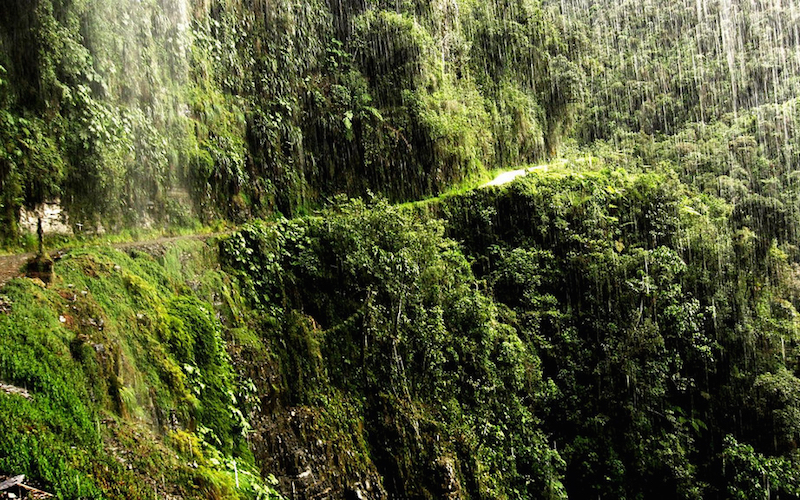
Argentina is Changing Chaco Forest
Every month on Earth Matters, a blog run by NASA, NASA offers an on-line puzzling satellite image and it challenges the general public to identify what part of the world is shown, when the image was acquired, what the image shows, and why the scene is interesting.
On the image exhibited on February 2016, NASA commented that it took Gavin McMorrow a mere 30 minutes to solve the puzzle, who also pointed out that the rectangular patterns which appeared in the image were cleared forest areas in Argentina’s Salta province.
While different parts of the world were noted as being the place of the image, such as California, Iowa, Wisconsin, Canada, Holland, Syria, Siberia and West Africa; there were a number of answers referring to Salta or Chaco Forest (which it also covers a surface in Brazil and Paraguay).
Interestingly, there were no definitive answers in relation to what the image shows. Even considering that most were referred to as agricultural possibilities, a wide range of agriproducts or activities were mentioned, including cranberries, tobacco, sugar cane, corn, vineyards, horticultural farms and general crops.
Remarkably, a respondent, Eva, noted the presence of burn scars and by answering “Chaco Forest in northern Argentina – decimated for livestock and crops, burn scars are visible,” directed the attention to the problem affecting the region, in particular, and Argentina, in general.
Becky Evermon also referred to the “Chaco forest burn area in Argentina” and Jessie Henshaw asked “Have you checked the correlation between the progression of forest burns and either local or global growth of GDP?”
After the replies, NASA provided details. Briefly, the false-color image of fields, forests, and puestos were in the Salta province of northern Argentina. Fires are actively burning in a few sectors of the grid.
NASA also explains that in the lower right of the image, several traditional puestos are visible as light green patches. These settlements usually consist of a few dwellings, farmhouses, and small-scale crops located near a well. Tree cover declines significantly at the center of a puesto because of heavy grazing by cattle, goats, and other free-ranging livestock near the water source. Ecologists call the distinctive grazing patterns biospheres.
To depict how profound is the change in Chaco Forest in Salta, NASA includes a reference to the field studies of Brandon Bestelemeyer, a U.S. Department of Agriculture ecologist, who began his research career two decades ago studying how competing land management systems—specifically whether people in local puestos kept grazing animals fenced—affected ant communities in this area. Other ecologists looked at the same question for reptiles and birds.
NASA continues remarking that since then, large sections of the Chaco Forests where Bestelemeyer did his research have been converted into large-scale farms. “My master’s thesis is now an anachronism,” he noted in a blog post and article for Rangelands. “Time will tell, but the pressure to convert the remaining forest will only increase. I’ve thought about going back to Salta to see what is happening firsthand, but there is no going back to the Chaco I once knew.”
Efforts to reduce deforestation
The governments of the United States and Norway released a joint statement during the conference recently held in Oslo to follow up the United Nations program aimed at Reducing Emissions from Deforestation and Forest Degradation (REDD+) in developing nations. The REDD Oslo Exchange conference was opened by Erna Solberg, Prime Minister of Norway and addressed by John Kerry, U. S. Secretary of State.
According to the joint statement, the collective goals set by the December 2015 Paris Agreement following the latest United Nations Framework Convention on Climate Change (UNFCCC) cannot be achieved without conserving, restoring and sustainably managing the world’s natural forests.
Both countries believe that a variety of tools are needed to support these efforts and resolve to continue and enhance cooperation on REDD+ and sustainable landscapes in order to:
- Support partner countries and other stakeholders in developing greenhouse gases (GHG) inventory, forest monitoring and MRV systems.
- Facilitate linkages of jurisdictional forest and climate programs with private sector commitments to reduce tropical deforestation in supply chains.
- Work with partners to promote deforestation-free commodity supply chains, building on the efforts of partner countries that are successfully implementing programs for reduced deforestation at a jurisdictional level.
- Clarify and strengthen the business case for sustainable investment.
- Enhance the use of development finance and assistance to mobilize private sector investment for forests and sustainable land use.
- Support states at the International Civil Aviation Organization (ICAO)’s 2016 Assembly to adopt a Global Market Based Measure to help to enable carbon neutral growth in international aviation from 2020.
- Affirm support for the new Capacity Building Initiative for Transparency. CBIT is designed to enhance institutional and technical capacity to build trust and confidence through transparency, and to meet international requirements for sound, consistent and comprehensive reporting, including mitigation in the land sector.
- Strengthen our respective efforts to fight illegal logging and associated trade.
- Provide technical tools and information to pension funds, finance agencies, and other investors seeking to reduce their impact on deforestation and forest emissions and support responsible forest management.
- Hold a bilateral expert-level meeting on forests once per year to promote close coordination on these activities.
The Norwegian parliament (Stortinget) has recently pledged to ensure deforestation-free supply chains through the government’s public procurement policy. While further details on the actual requirements will be elaborated upon, it is expected that goods which are linked to the destruction of the rainforest, such as palm oil, tropical timber, soy and paper will be addressed.
Norway is the first country to commit to zero deforestation in its public procurement, and is calling for other countries to consider adopting a similar zero deforestation commitment. In particular, Germany and the UK must act, following their joint statement at the UNFCCC Summit.
Minister of Climate and Environment, Vidar Helgesen, also announced that Norway will continue supporting the forest information and monitoring system Global Forest Watch (GFW) to bring radical transparency to land use change in real time as such information is crucial to halt tropical forest loss. The world’s three largest rainforest nations – Brazil, the Democratic Republic of Congo and Indonesia – have all published information about their land use in GFW.
Vidar Helgesen also remarked that stronger political leadership is needed to amplify the voices and role of indigenous people in forest conservation.
The pivotal role of indigenous peoples in forest land management is an essential component of the reasoning behind the Norwegian International Climate and Forest Initiative (NICFI) which provides funds to result-based partnerships in Brazil, Colombia, Ethiopia, Guyana, Indonesia, Liberia, Mexico, Tanzania, Vietnam and in the Congo Basin. NICFI was established in 2008 and extended up to 2030, following the Paris UNFCCC summit.
The Norwegian parliament provided guidance regarding the direction of the policies for the NICFI, noting that the rainforest is usually better protected where indigenous peoples and other forest peoples are in control of their territories. It also recognized that although climate change is the main driver behind NICFI, is also important to attain results within several different areas –strengthening of the rights of indigenous peoples and implementing governmental reforms in forest countries where corruption practices may be an obstacle.
Chaco forest can’t be restored
Against the backdrop of the international concerns due to deforestation, the image and the commentary provided by the respondents of the NASA puzzle referred to above are pertinent in addressing the critical situation of native forests in Argentina and its bad perspectives.
Gavin McMorrow remarks did not only provide a rapid answer identifying the place of the world, but also provided a clue as to what has been going on in this part of the world by including the exact coordinates: “Salta Province, #Argentina: Exact coords -24°54.324, -063°08.679.”
As the coordinates are nearby Las Lajitas, the epicenter of the soybean developments in Salta Province of Argentina; we can relate the place to the fact of the timing of the studies conducted by Brandon Bestelemeyer, twenty years ago. Argentina approved the use of transgenic soybean seeds.
Argentina lost around 60% to 70% of its endowment of native forests; being a sizeable portion of such lost the result of the massive extension of the agricultural frontier due to the transgenetic soybean developments.
Even when Act 26.331, aimed at protecting native forests such as Chaco Forest, was enacted in Argentina in 2007 following massive demonstrations of more than 1.5 million people around the whole country, the trend towards deforestation has remained at high levels, and has only shown a reduction in the year 2014, due to the lowering trend in the prices of soybean at the time and the increasing costs and difficulties arising in the transportation of the crops to local processing centers or exporting ports.
In the future, the trend towards a further extension of the agricultural area is not only expected to continue, but is deemed to increase as the initial economic measures implemented by President Mauricio Macri, export duties applied to practically all agricultural products were phased-out, while the export duties applicable for soybean crop were reduced. These measurements compounded the positive effects for exporters derived from the devaluation of the local peso. To de-bottleneck the logistic constraint, President Mauricio Macri´s administration is starting the bidding process to refurbish the local railway services.
Eroding the case for the conservation of native forests, the ad-hoc funding designated by the Act 26.331 to support the initiatives of the Act 26.331, including compensation to land-owners willing to conserve native forests in their lands were drastically reduced as the source of such funds are a low percentage of the now removed or decreased export duties. Besides, from the perspective of policy making, while many business representatives are calling for a modification of the Act 26.331 to remove obstacles to agricultural developments, Minister of the Environment and Sustainable Development Rabi S. Bergman also includes references removing limits to agriculture in his rhetoric.
Regarding, the Chaco Forest, several corporations (national and international) were allowed to clear the native forest (desmonte, in Spanish) in Salta Province to establish large agricultural undertakings even after the enactment of the Act to protect the forests. Indeed, a great proportion of the forest area in the Province was re-assessed as being not at risk for allowing such desmontes by the recent Governors of the Province, J. Romero and J. Urtubey. A report questioning the desmontes in Salta Province was recently released by Greenpeace which questions the re-assessments of the forest inventory by the Province and includes the identification of the owners of the lands where the desmontes took place.

